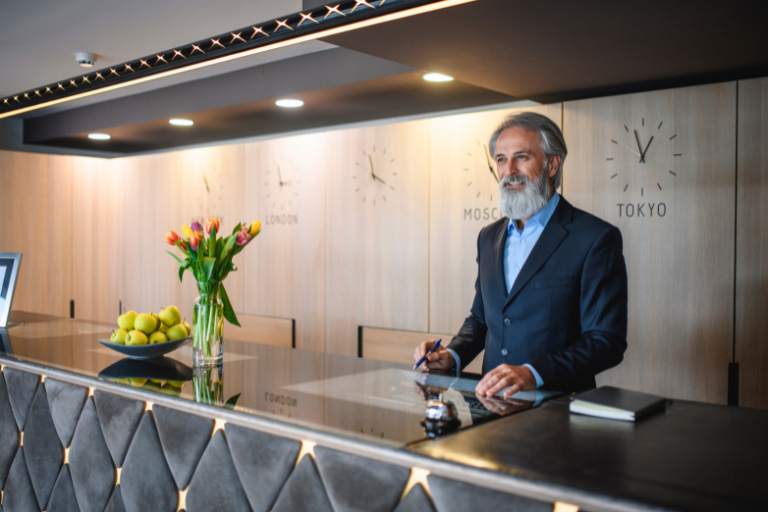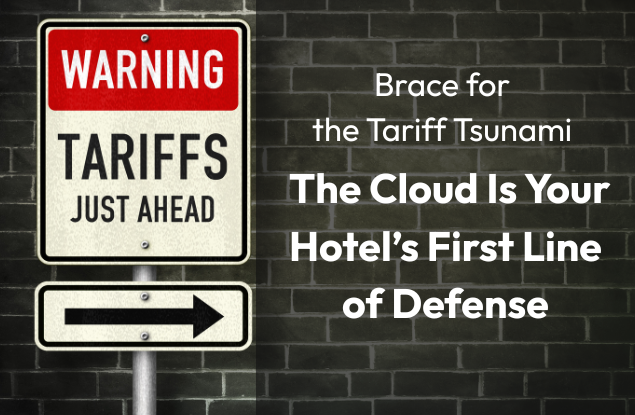Running a successful hotel can often feel like a high-wire act, balancing the need to cut costs with maintaining the highest quality of service for your guests. If you tip too far one way, your budget takes a hit. Lean too far the other way, you risk guest dissatisfaction and negative reviews.
Whether and how a hotel can prosper also depends on a number of external factors, including season, the current state of the economy, and the labor market. Here is when strategies that leverage technology, energy efficiency and optimize workforce productivity come to aid.
In this article, we will begin by breaking down hotel expenses, calculating key performance metrics, and then we will share three strategies to reduce costs while keeping the guest experience up.
How to keep track of your hotel operational costs
Hotel costs can be split into two groups – fixed and variable costs.
What are the fixed costs in a hotel?
- Rental fees, property taxes, and franchise fees
- Labor cost (payroll, health care, insurance…)
- Monthly bills like internet, phone, and TV
- Technology, hotel management software (for example fixed monthly subscription fees)
Fixed costs, as the name implies, are the type of expenses that leave your bank account on a regular basis in a set amount. These expenses don’t directly depend on occupancy rates and are not tied to usage. Therefore, they are easier to calculate in your revenue forecasts.
What falls under variable costs?
- Utilities such as water, electricity
- Housekeeping and F&B supplies
- Maintenance costs
- Marketing costs
- OTA commissions
- Hourly wages cost for short-term staff
Variable costs keep changing, depending on occupancy, or usage. They are harder to predict. However, there are many tracking systems on the market, such as energy management systems and predictive maintenance systems, that help you get more insights into these expenses.
Breaking down your operational expenses
After you have put all your expenses together (both fixed and variable), creating a profit and loss sheet helps you keep track of overall hotel operational costs. This also helps you to understand what your net profit is, where the budget goes, and why. You will then be able to use those numbers to calculate your KPIs and set objectives to adjust your spending without affecting the guest experience.
Here are some key metrics that will help you understand the state of your finances on a much deeper level:
CostPAR (Cost Per Available Room)
This measure will give you the total costs incurred in making a room available for sale, divided by the total number of available rooms. To calculate this, add up all your costs associated with room availability (both fixed and variable costs) and divide it by the total number of rooms available. This value can be calculated per month or per day.
CostPAR = total room costs/ number of rooms available
COPR (Cost Per Occupied Room)
Cost per occupied room takes into account the total cost of producing and servicing rooms and tells you if the operating expenses are too high or could be optimized. This includes costs related to cleaning, maintenance, and laundry. To calculate it, divide the total cost related to room servicing by the total number of rooms sold.
COPR = total servicing room costs/ number of rooms sold
RevPAR (Revenue Per Available Room)
RevPAR value tells you how well you are able to book your rooms and uncovers whether you are maximizing revenue or if there is a room to adjust pricing. To calculate RevPAR, you’ll need to know your Occupancy Rate – OR (total rooms sold/ total rooms available) and Average Daily Rate – ADR (room revenue/ rooms sold). There are two ways to get RevPAR, you can either multiply ADR by OR, or divide total room revenue by number of rooms available.
- RevPAR = ADR x OR
- RevPAR = total room revenue/ number of rooms available
GAC (Guest Acquisition Cost)
This number measures how much it costs a hotel to acquire a new guest. It includes costs like marketing, sales, distribution, and reservations systems. To calculate this, add up all the costs associated with acquiring a guest (marketing, commissions, etc.) and divide it by the total number of guests acquired.
GAC = total costs to acquire a new guest/ number of guests acquired
Reduce hotel operating costs without compromising guest experience
Now that you understand your profit and expenses, you’ll be able to come up with objectives and plans to lower operational costs. The following strategies will help you to do so in a way that will not affect the guest experience.
Leverage technology – Cutting your hotel costs and upping your service game
Hotel technology is here to save you time and reduce operating costs through workflow automation. Plus, if you go with AI-driven solutions you’ll be able to take the guesswork out of your strategies, replace it with real data and generate predictions that will help you maintain the best possible service and operations.
Here are key examples of advanced hotel technology that keeps expenses low and your guest satisfaction high.
Revenue management intelligence
A revenue management system is a key strategic tool for maximizing hotel revenue. It crunches through historical data, real-time data, and market trends, pinpointing the best pricing for rooms each day. This system not only maximizes your revenue but also assists you with dynamic pricing based on different factors like seasonality, demand, or competition.
Thanks to intelligent algorithms, it rolls out package rates automatically, offering guests multiple booking options based on their preferences. So, while you're effectively reducing costs, your guests enjoy a seamless and personalized service. Simple, yet effective!
Automate task management
Through room request automation, such as housekeeping software and task management software, you're not only saving time on handling room request calls at the front desk but also helping your other teams to become more efficient.
Let's face it, guests often need to get in touch with the front desk for room service, upgrades, or extras. Any hiccup when they're trying to order room service or book a table is potentially lost revenue. The goal is to make their communication with your team as easy as possible.
That is why having a system that lets guests book services or send feedback benefits your team from day one. It lessens the call load, saves you money, helps your team members to keep track of their to-dos, and opens new ways to boost your revenue.
In-room AI Assistants
In-room AI assistants can be a lifeline for hotel staff in times of staff shortages. They make communication with your guests so much easier, faster and can substantially reduce training costs for new staff members.
These devices help automate repetitive guest queries, allowing your teams to direct their focus on service. AI assistants respond to your guests instantly and accurately point them in the right direction, letting them order extra amenities, and helping you attend to anything the guests are interested in without getting your human staff involved.
Advanced hotel-only AI systems carry out multiple roles so that you will save costs and space in the guest room and enhance your guest experience. We’re talking personalized holiday tips, in-room telephone, Bluetooth speaker, alarm, and connecting IoT in-room devices. These systems also learn from every interaction with users and tailor their offers to what the guests like. You will also get to see all insights from guest-to-AI interactions in your PMS or CRM software.
Predictive maintenance
Predictive maintenance systems use intelligent algorithms to detect a potential failure in your equipment early and help to prevent a major breakdown or emergency. Hotels with smart room controls or IoT devices benefit from this technology.
These AI platforms help you oversee the health of your infrastructure and predict which ones are more likely to break. You will thus be able to maximize the lifetime of your equipment and avoid major repairs and equipment downtime. More importantly, you can use this information to schedule maintenance for equipment well before critical problems arise.
Power down to save up – The benefits of energy conservation
Though efficient technology and energy monitoring software require a large upfront investment, it will save you money and prevent energy waste in the long run. On top of that, hotel brands that adopt environmentally responsible approaches are becoming a priority for today’s travelers.
What energy-efficient options do hotels have?
Measuring energy performance and benchmarking is your secret weapon to identify inefficiencies and slash energy costs. You can do it yourself with designated software or outsource an energy audit.
If busy seasons are leading to huge energy bills for you, you can consider implementing smart thermostats and room management systems (IoT), motion-sensor lighting, and use your in-room communication channels for campaigns to encourage the reuse of towels and opt-out housekeeping. Make sure that your staff is on the same page and understands how to take action to minimize waste, or you can also hear their ideas on how to save energy.
Lastly, maintaining your equipment on a regular basis prevents costly repairs or urgent replacements in the future. To take it one step further, you can opt for predictive maintenance software (as mentioned above) that helps you track the health of your equipment and predict problems before they surface.
Optimize labor – Maximize your team’s productivity
Given the current job market, putting together a skilled and efficient team that offers great service is not an easy task. Your employees are the heart of your hotel, which understandably makes labor costs your major expense.
To save time and budget, consider putting effort into making their daily routines as streamlined as possible. Ask yourself or better yet, ask your employees to hint at how you can make their work easier. Augmenting their workflows in terms of faster communication, task management, and automating repetitive work will do wonders for your team’s productivity and improve service satisfaction.
For example, you can pick software and tools that help your teams communicate, and let your staff handle their to-dos from their mobile devices, so that the important information does not get lost. We cannot stress enough how important your hotel software ecosystem will be in the future. Therefore, keep in mind the big picture and strategically pick solutions that will not only work together but also complement each other’s functionality.
Conclusion
In this article, we have unpacked hotel costs, explored the key metrics, and shared strategies to cut operating costs without letting your service quality slip. It is essential to keep in mind that this cost efficiency isn't just about saving money — it's about making every penny count.
Technology, from automation to AI, can help you do that. It simplifies your work, saves you money, and offers your guests something a little extra. For example, focusing on energy efficiency is a win-win. It is good for the planet and your budget, and when it comes to your team — the more efficient they are, the better the service they can provide.
Whether you’re on a journey towards cost-efficiency or ramping up guest experience, smooth communication is the key to success. Our voice AI system links your teams to the guests and each other, while keeping track of all conversations in your favorite PMS. Get in touch with us for a free consultation.
Book a free demo with us ↓
Do you want to learn more about voice AI technology for hotels? Sign up for a free demo.







